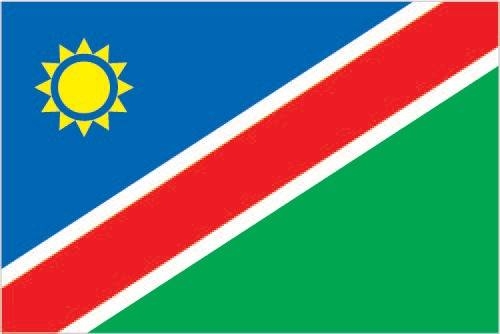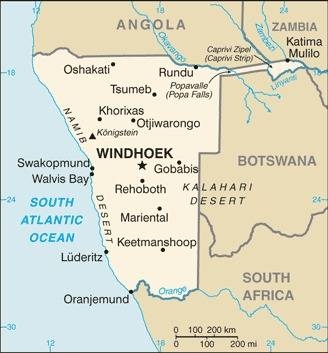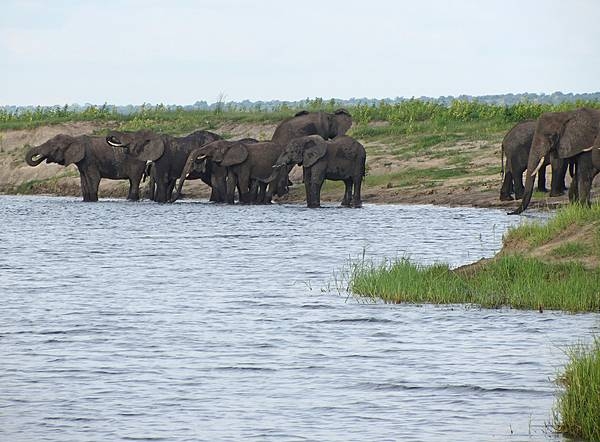213 Namibia

A wide red stripe edged by narrow white stripes divides the flag diagonally from lower hoist corner to upper fly corner. The upper hoist-side triangle is blue and charged with a golden-yellow, 12-rayed sunburst. The lower fly-side triangle is green. Red signifies the heroism of the people and their determination to build a future of equal opportunity for all. White stands for peace, unity, tranquility, and harmony. Blue represents the Namibian sky and the Atlantic Ocean, the country’s precious water resources and rain. The golden-yellow sun denotes power and existence. Green symbolizes vegetation and agricultural resources.
Flag courtesy of the CIA World Factbook

Map courtesy of the CIA World Factbook

A herd of elephants along the Chobe River.
Photo courtesy of the CIA World Factbook
Government
According to Britannica, Namibia is a republic. The country’s constitution, which took effect at independence in 1990 and has since been amended, is highly rights-conscious and aimed at achieving a durable separation of powers. Executive power is vested in the president, who serves as head of state and government and is directly elected to a five-year term, the vice president, who is appointed by the president, and the cabinet, which consists of the prime minister and other ministers who are also appointed by the president.
Legislative power is vested in the bicameral Parliament. The National Assembly is constituted to initiate and pass legislation. It consists of 96 members who are directly elected to five-year terms under universal adult suffrage and up to 8 members who are appointed by the president and do not have voting rights. The second house, the National Council, serves in an advisory capacity on legislative matters and comprises three representatives from each of Namibia’s 14 administrative regions. National Council members are elected by Regional Councils and serve six-year terms.
The judicial system comprises the Supreme Court, the High Court, and lower courts.
Internationally, Namibia hastened to join regional organizations (e.g., the Southern African Development Coordination Conference and the Organization of African Unity, now the African Union) as well as global bodies (the World Bank, the International Monetary Fund, the EC Lomé Conventions, and the Commonwealth). Its relations with South Africa have been pragmatic and surprisingly non-contentious (on the South African side as well).
Namibia Civil Aviation Authority (NCAA)
The Namibia Civil Aviation Authority (NCAA) is a state-owned enterprise established in terms of the Civil Aviation Act, 2016 (Act No. 6 of 2016). It commenced operating on 1 November 2016. The Act provides for, amongst others:
- The establishment of the Namibia Civil Aviation Authority,
- The establishment of the Air Navigation Services (ANS) in the Authority; and
- The provision for a civil aviation regulatory and control framework for maintaining, enhancing and promoting the safety and security of civil aviation for ensuring the implementation of international aviation agreements.
The NCAA functions autonomously under a Board of Directors, appointed by the Minister of Works and Transport in his capacity as the portfolio Minister. As such, it is the independent statutory authority of Namibia’s civil aviation industry. Its key role is to conduct the safety and security regulation of civil air operations in Namibia’s airspace, and to provide air navigational services to all airspace users. Flowing from its objectives, the NCAA performs the following functions:
- Legal Framework
- Administrative Functions
- Human Resources Functions
Airspace
SkyVector – Google Maps – ADS-B Exchange
ICAO countries publish an Aeronautical Information Publication (AIP). This document is divided into three parts: General (GEN), En Route (ENR) and Aerodromes (AD). ENR 1.4 details the types of airspace classes they chose to adopt from classes A through G.
Drone Regulations
NAMCAR Part 101 – 27 March 2020
NCAA RPAS Instructions June 2021
FSS-OPS-FORM-612-01 RPA Application Form Rev 3
FSS-OPS-FORM-612-01 Rev 3 Example filled in
NCAA RPAS Map Submission Example-Template
FSS-OPS-FORM-612-05B RPAS Approval Checklist Rev 1
FSS-ANSSO-FORM15-18D Applicant Risk Assessment Template
Advanced Air Mobility (AAM) Regulations & Policies
None found by the author.
However, should you, the reader, happen to stumble across something to the contrary, please email the author at FISHE5CA@erau.edu and you may be mentioned in the ACKNOWLEDGEMENTS section of this book by way of thanks for contributing to this free eBook!
Advanced Air Mobility (AAM) News
None found by the author.
However, should you, the reader, happen to stumble across something to the contrary, please email the author at FISHE5CA@erau.edu and you may be mentioned in the ACKNOWLEDGEMENTS section of this book by way of thanks for contributing to this free eBook!
Short Essay Questions
Scenario-Based Question
You have been hired by a Drone Startup Company. Your boss has immediately assigned this job to you.
They need you to prepare a one-page memo detailing the legalities of using a drone to search for elephants near the Chobe River.
They need you to mention any national laws and local ordinances.
They specifically want to know what airspace (insert pictures) you will be operating in and whether or not you need an airspace authorization.
Does it matter whether or not you are a citizen of the country?
Lastly, there is a bonus for you if, as you scroll through this chapter, you find any typos or broken links!
Short Essay Questions
- What are the drone categories?
- How is registration addressed?
- How is remote ID addressed?
- What are the model aircraft rules?
- What are the commercial drone rules?
- Are there waivers or exemptions to the rules? If so, for what?
- Would you share a link to an interactive airspace map?
- How is BVLOS addressed?
- How can you fly drones at night?
- How can you fly drones over people?
- Where do you find drone NOTAMs?
- What are the rules for drone maintenance?
- What are the rules for an SMS program?
- What are some unique rules not mentioned above?
- What are the C-UAS rules?
- What are the AAM rules?

